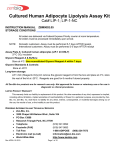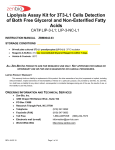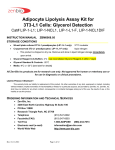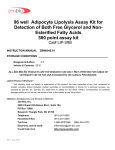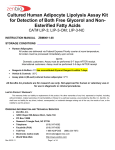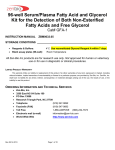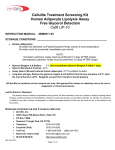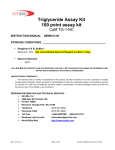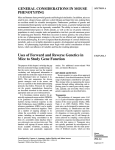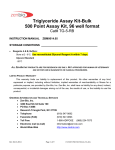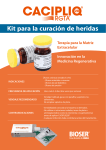Download Glycerol Detection 500 point kit (LIP
Transcript
Cultured Human Adipocyte Lipolysis Assay Kit-500 point assay kit 96-well Format Cat# LIP-1-RB INSTRUCTION MANUAL ZBM0027.04 STORAGE CONDITIONS All orders are delivered via Federal Express Priority courier at ambient temperature. All orders must be processed immediately upon arrival. Glycerol Reagent A & Buffers: Store at 4C. Glycerol Standards & Controls: Store at -20°C ALL ZEN-BIO INC PRODUCTS ARE FOR RESEARCH USE ONLY. NOT APPROVED FOR HUMAN OR VETERINARY USE OR FOR USE IN DIAGNOSTIC OR CLINICAL PROCEDURES. LIMITED PRODUCT WARRANTY This warranty limits our liability to replacement of this product. No other warranties of any kind, expressed or implied, including without limitation, implied warranties of merchantability or fitness for a particular purpose, are provided by Zen-Bio, Inc. Zen-Bio, Inc. shall have no liability for any direct, indirect, consequential, or incidental damages arising out of the use, the results of use, or the inability to use this product. ORDERING INFORMATION AND TECHNICAL SERVICES Zen-Bio, Inc. 3200 Chapel Hill-Nelson Blvd., Suite 104 PO Box 13888 Research Triangle Park, NC 27709 Telephone (919) 547-0692 Facsimile (FAX) (919) 547-0693 Toll Free Electronic mail (e-mail) World Wide Web Rev 06.2009 1-866-ADIPOSE (866)-234-7673 [email protected] http://www.zenbio.com Page 1 of 11 INTRODUCTION . Lipolysis plays a central role in the regulation of energy balance. Lipolysis is the process in which triglycerides (TG) are hydrolyzed into glycerol and free fatty acids. This process releases free fatty acids (FFA) into the bloodstream where they may be either re-esterified by the adipocyte or travel to other tissues and exert other effects throughout the body. Elevated adipocyte lipolysis has been observed in obese and diabetic individuals (Arner 1996). Excessive free fatty acid production is believed to contribute to insulin resistance in skeletal muscle that is observed in obesity. Hormone sensitive lipase is the rate-limiting enzyme catalyzing triglyceride breakdown. Perilipins, one of the PAT (perilipins, adipophilin, TIP47 proteins) family of lipid-associated proteins, are implicated in adipocyte lipolysis by mediating the interaction of HSL with the triacylglycerol molecule (Brasaemle et al. 2004; reviewed in, Tansey et al. 2004.) The presence of these proteins corresponds to lipolytic stimulation in cultured adipocytes (Braemle et al. 2004). The sympathetic nervous system also plays a key role in the regulation of lipid mobilization. The main lipolytic pathway involves beta-agonists (-agonists), which activate -adrenergic receptors via the intracellular Gs proteins in adipocytes. This leads to the activation of adenylate cyclase (AC), which then increases cyclic AMP (cAMP) levels. Elevated cAMP acts as a second messenger to activate hormone sensitive lipase (HSL). HSL, the rate-limiting enzyme regulating adipocyte lipolysis, then catalyzes the hydrolysis of triglycerides and results in the release of glycerol and FFA (increased lipolysis). Phosphodiesterases (PDE) are enzymes that hydrolyze cAMP to 5’-AMP (5 prime adenosine monophosphate). This action results in a decrease in lipolysis. PDE inhibitors increase intracellular cAMP levels. 3-isobutyl-1-methylxanthine (IBMX), a non-specific inhibitor of cAMP phosphodiesterases (PDE), is used as the positive control if your test compounds are suspected PDE inhibitors. Isoproterenol, a non-specific -adrenergic agonist is used as the positive control if your test compounds affect lipolysis via -adrenergic receptors (Robidoux et al. 2004). This lipolysis assay kit provides the tool to study chemical compounds that may influence lipolysis in cultured human adipocytes. This kit detects lipolysis as the amount of glycerol released from mammalian cells in a 96-well format. This kit contains sufficient volume of reagents to assay 500 data points (~5 96 well plates). Rev 06.2009 Page 2 of 11 Figure 1. Overview of adipocyte lipolysis EPINEPHRINE 1 , 2 , 3 AR NOREPINEPHRINE AC Gs IR PDE ATP P cAMP 5’-AMP PKA ABBREVIATIONS: AC adenylate cyclase AR adrenergic receptors Gs G protein coupled receptor FFA free fatty acids PKA protein kinase AMP adenosine monophosphate ATP adenosine triphosphate IR insulin receptor PDE phosphodiesterase TG triglyceride HSL TG FFA + glycerol FFA + glycerol bloodstream PRINCIPLE OF THE ASSAY Glycerol released to the medium is phosphorylated by adenosine triphosphate (ATP) forming glycerol-1-phosphate (G-1-P) and adenosine-5’-diphosphate (ADP) in the reaction catalyzed by glycerol kinase. G-1-P is then oxidized by glycerol phosphate oxidase to dihydroxyacetone phosphate (DAP) and hydrogen peroxide (H2O2). A quinoneimine dye is produced by the peroxidase catalyzed coupling of 4-aminoantipyrine (4-AAP) and sodium N-ethyl-N-(3-sulfopropyl)m-anisidine (ESPA) with H2O2, which shows an absorbance maximum at 540nm. The increase in absorbance at 540nm is directly proportional to glycerol concentration of the sample. GLYCEROL + ATP G-1-P + ADP G-1-P + O2 DAP + H2O2 H2O2 + 4-AAP + ESPA Rev 06.2009 Page 3 of 11 Quinoneimine dye + H2O ITEMS INCLUDED IN THE KIT UNIT QTY STORAGE 500 ml Wash Buffer 250 ml Glycerol Reagent A 40-ml- Reconstitute with 40 ml (cat# RGTA-40) deionized water prior to use. BOTTLE BOTTLE 40ML BOTTLE 1 1 1 4°C 4°C Glycerol Reagent A 11-ml- Reconstitute with 11 ml (cat# RGTA-10) deionized water prior to use. 11ML BOTTLE 1 100 l / VIAL 2 -20°C ITEM LIP-1 Assay Buffer DESCRIPTION 4°C 4°C Glycerol standard Glycerol @ 1mM [Reconstitute (cat# LIP-GLYSTAN) with 400 l Wash Buffer to Orange cap make the 200 M glycerol standard; see page 6 for recommended dilution scheme] Vehicle Control Green cap 0.1% DMSO in Assay Buffer 1 ml / VIAL 2 -20°C Positive control Blue cap Isoproterenol, 10 mM in 10 l / VIAL 2 -20°C DMSO. Dilute to 1 M in Assay Buffer before use! (i.e.1 l in 10 ml Assay Buffer) Other equipment/reagents required but not provided with the kit: Clean/disposable pipettor trays Blank 96 well plates Multi-channel Pipet , single channel pipet and pipet tips Plate reader with a filter of 540 nm Incubator at 37oC Large gauge needle Cultured human adipocytes Tubes for diluting glycerol standards Rev 06.2009 Page 4 of 11 ASSAY PROCEDURE 1. Please observe your cells under a microscope prior to performing the assay. 2. Make your stock solution using whatever vehicle is appropriate for your test compounds. Dilute your stock solutions to their final concentration in Assay Buffer (500 ml is available). NOTE: if desired, maintain a constant concentration of solvent by preparing all compound dilutions in the highest concentration of that solvent. Dilute your controls in Assay Buffer. Prepare all vehicles as appropriate for your compounds. Include the Assay Buffer alone as a vehicle control. PLEASE NOTE: ZEN-BIO DOES NOT RECOMMEND THE USE OF SOLVENTS AT CONCENTRATIONS ABOVE 1%. 3. Remove 120 l medium from each well. Gently add 200 l Wash Buffer to all wells. Remove 200 l of the media and Wash Buffer from each well and replace with another 200 l Wash Buffer. 4. Remove all the media and Wash Buffer from the cells from triplicate wells. Treat the cells with 150 l of the test compounds resuspended in Assay Buffer three (3) wells at a time. You can treat with isoproterenol in assay buffer as the positive control (not provided in this kit). Use the Assay Buffer alone as one of the vehicle controls. Please be sure to include your vehicle (if your test compounds are not dissolved in DMSO). The assay should be performed in triplicate. 5. OPTION: to determine if the compound alone reacts with the Glycerol Reagent A, prepare a fresh plate (not included in kit) containing 100 l of the compound. This plate can be incubated at 37 oC with the treated cells. When performing the assay, add 100 l of Glycerol Reagent A following the instructions in Steps 10 and 11. 6. Incubate the plates at 37oC-humidified incubator for 3 hours (for time course experiments the longest time point is usually 24 hours). 7. One hour prior to the assay, prepare the glycerol standards as follows: Briefly spin down the contents of the glycerol standard tube before reconstitution. Pipette 400 l of Wash Buffer into the 1 mM glycerol standard tube provided and mix well by vortexing. This produces a diluted stock glycerol standard of 200 M. Pipette 250 l of wash buffer into 6 tubes (not provided). Using the newly diluted stock glycerol solution, prepare a dilution series as depicted below. Mix each new dilution Rev 06.2009 Page 5 of 11 thoroughly before proceeding to the next. The 200 M stock dilution serves as the highest standard, and the wash buffer serves as the zero standard. 400 l Wash Buffer 250 l 250 l 250 l 250 l 250 l 250 l Std 200 M 100 M 50 M 25 M 12.5 M 6.25 M 3.125 M Note: The above dilution series generates enough volume to perform the standard curve in duplicate. If you wish to perform the standard curve in duplicate, please note that eight fewer data points can be assayed with this kit. 8. At this time prepare the Glycerol Reagent A by adding 40 ml or 11 ml room temperature deionized water per bottle following the instructions on the bottle. Gently invert bottle to mix contents. DO NOT VORTEX! Use a pipet to ensure that the powder is completely dissolved. Store in a light protected bottle. Reconstituted Glycerol Reagent A is stable for 60 days refrigerated (2-8C); store any remaining solution refrigerated (2-8C). You may order additional glycerol standards for the Lipolysis Kit (cat# LIP-GLYSTAN). 9. At the end of the incubation, 100 l of the conditioned media is removed and transferred to the corresponding well of another blank plate. [This is most easily accomplished using a multi-channel pipet.] Add 100 l of each glycerol standard to any remaining empty wells in one of the blank assay plates. 10. Add the reconstituted Glycerol Reagent A solution to a disposable tray (not provided). Add 100 l of Reagent A to each well of the assay plates containing samples. Gently, pipet up and down once to mix. Pop the bubbles using a large gauge needle or a clean pipet tip. The plate is then incubated at 25 oC (room temperature) for 15 minutes. 11. The optical density of each well is then measured at 540 nm. Rev 06.2009 Page 6 of 11 GLYCEROL STANDARD CURVE . Generate standard curve: see example below [DO NOT use this standard curve to generate your data. This is an example.] Subtract the OD value of the 0M standard from all OD values including the standard curve. uM glycerol ODblank ODblank Avg ODblank OD OD 0 0.044 0.041 3.125 0.054 0.053 0.012 0.011 0.011 6.25 0.062 0.063 0.020 0.021 0.020 12.5 0.083 0.084 0.041 0.042 0.041 25 0.126 0.125 0.084 0.083 0.083 50 0.205 0.208 0.163 0.166 0.164 100 0.372 0.374 0.330 0.332 0.331 200 0.698 0.697 0.656 0.655 0.655 Slope 0.003 Intercept 0.001 2 R 0.043 1.000 y = observed O.D. minus the blank x = concentration of glycerol in M To calculate x for each y, (i.e. to change the observed O.D. into glycerol concentration) use the following equation: y=(slope) times (x) plus intercept y=mx+b so x=(y-b)/m x=(y – (0.001))/0.003 where 0.003= slope of the line and 0.001= y intercept. Be careful to enter the proper sign for the y intercept value as it may be a negative number. Any OD values greater than the highest standard (200 M) should be suspect. The compound should be re-assayed using a lower dose of the compound at treatment OR a dilute solution of the condition medium at the time of the assay. The R2 value should be equal or greater then 0.98 for the standard curve to be valid. Any R2 values below 0.98, must have the standard curve run again. Data are expressed as M glycerol released. OPTION: express data as Fold induction over appropriate vehicle Fold induction = M glycerol SAMPLE M glycerol VEHICLE Rev 06.2009 Page 7 of 11 TROUBLESHOOTING . Problem High background or the glycerol reagent A turns purple before the assay begins. No response to positive control Suggestions Change pipet tips frequently Use Glycerol Reagent A before the expiration date Do not add the compounds and controls too fast. The cells can float if a solution is added too fast. Make sure to starve the cells for 5-7 days BEFORE initiating treatment. Edge effects Inconsistent OD reading Ensure a saturated humidity in the incubator to prevent evaporation from the outside wells The Assay Buffer contains bovine serum albumin (BSA). Be careful when pipetting to avoid bubbles. If bubbles persist, burst the bubbles using a large gauge needle and read the plate again. FREQUENTLY ASKED QUESTIONS . 1. I want to perform a lipolysis time course experiment. How many time points can I complete ? We do not recommend performing more than 2 time points per assay. For time course experiments, add 250 l assay medium with treatments per well. Remove 100 l for each time point. Complete the assay using an equal volume Glycerol Reagent A. 2. I do not have time to perform the assay. Can I freeze the conditioned media? How long can I store the samples before I complete the assay? Yes. The conditioned media can be immediately stored at -80C for a maximum of 7 days in regular polystyrene cell culture plates. Bring the conditioned media in the plate to room temperature BEFORE adding the Glycerol Reagent A and completing the assay. 3. Can I buy the reagents separately? The Glycerol Standard, cat# LIP-GLYSTAN and Glycerol Reagent A, cat# RGTA-10 (11 ml), RGTA-40 (40 ml) are sold separately. Assay Buffer is not sold separately. 4. I need to know the concentration of the BSA in the Assay Buffer? ZenBio, Inc does not provide the concentrations of the components of our media and buffers. If knowledge of the BSA concentration is critical to your experiment, you may order Assay Buffer WITHOUT BSA for no additional charge. Please note it on your order. Rev 06.2009 Page 8 of 11 REFERENCES 1. Arner P (1996) Diabetes Rev 4(4):450-463. 2. Botion LM & Green A. Diabetes (1999) 48:1691-1697 3. Brasaemle DL, Dolios G, Shapiro L, Wang R. (2004) J Biol Chem 279(45): 46835-42. 4. Cooper DMF, Schlegel W, Lin MC, Rodbell M. (1979) J Biol Chem 254(18):8927-8931. 5. Dyck DJ Can J Appl Physiol (2000) 25(6):495-523. 6. Kordik CP & Reitz AB. J Medicinal Chem (1999) 42(2):181-201. 7. Rieusset J, Chambrier C, Bouzakri K, Dussere E, Auwerx J, Riou J-P, Laville M, Vidal H. Diabetologia (2001) 44:544-554. 8. Robidoux J, Martin TL, Collins S. (2004) Ann Rev Chem 253: 7570-7578. 9. Scriba D, Aprath-Husmann I, Blum WF, Hauner H. Eur J Endocrinol (2000) 143:439-445 10. Snyder PB Emerging Therapeutic Targets (1999) 3(4): 587-599. 11. Tansey JT, Sztalryd C, Hlavin EM, Kimmel AR, Londos C. (2004) IUBMB Life 56(7): 379-85. Rev 06.2009 Page 9 of 11 APPENDIX A: PLATE LAYOUT . A B C D E F G H 1 2 3 4 5 6 7 8 9 10 11 12 Rev 06.2009 Page 10 of 11 APPENDIX B: PROCEDURE FLOWCHART Make all test compound dilutions in Assay Buffer. Remove 120 l media from all wells. Add 200 l Wash Buffer to all wells. OOOOOOOOOOOO OOOOOOOOOOOO OOOOOOOOOOOO OOOOOOOOOOOO OOOOOOOOOOOO 120 l media 200 l Wash Buffer 200 l Wash Buffer Remove 200 l media & Wash Buffer. Add another 200 l Wash Buffer to all wells. Remove all media & Wash Buffer. Add 150 l treatments/controls to 3 wells at a time. OPTION: Add 100 l/well compounds to a fresh plate without cells. OOOOOOOOOOOO OOOOOOOOOOOO OOOOOOOOOOOO OOOOOOOOOOOO OOOOOOOOOOOO OOOOOOOOOOOO OOOOOOOOOOOO OOOOOOOOOOOO OOOOOOOOOOOO OOOOOOOOOOOO Add another 200 l Wash Buffer Remove 3 wells at a time Add treatments 3 wells at a time Incubate 3-5 hours at 37oC. One hour prior to assay, reconstitute Glycerol Reagent A and prepare standards. Keep all at room temp. Remove 100 l/well conditioned media to a blank assay plate (not provided). Add standard dilutions. OOOOOOOOOOOO OOOOOOOOOOOO OOOOOOOOOOOO OOOOOOOOOOOO OOOOOOOOOOOO Add 100 l/well reconstituted Glycerol Reagent A to the plate (including the glycerol standards at 100l/well) and optional plate without cells. OOOOOOOOOOOO OOOOOOOOOOOO OOOOOOOOOOOO OOOOOOOOOOOO OOOOOOOOOOOO Incubate at 25oC (room temperature) for 15 minutes. Pop the bubbles in each well. Measure the optical density of each well at 540 nm using a spectrophotometer plate reader. Rev 06.2009 Page 11 of 11 100 l OOOOOOOOOOOO OOOOOOOOOOOO OOOOOOOOOOOO OOOOOOOOOOOO OOOOOOOOOOOO GLYCEROL REAGENT A OOO OOO OOO OOO OOO An additional blank assay plate may be necessary for the assay of glycerol standards if al 96 wells are used. (not provided)











